
1.Describe, with the aid of sketches, how an axial piston pump can vary the volume of liquid it displaces.(10)

- Describe, with the aid of sketches, the operating principle of an axial variable delivery hydraulic pump.(10)

- Describe, with the aid of a sketch, the operation of a variable delivery axial piston pump.
(10)

- With reference to a pressure compensated variable displacement, swash plate pump, explain FOUR different possible causes of reduction in performance.
Note: The filter has been cleaned, the system is in good condition and there are no visual signs.
(10)

Question
- Although the question clearly states that the system is in good condition, many give low / high viscosity, air etc. Many give worn pistons but no explanation as to why the performance is affected unless they explain I can’t award marks. Few appear to understand what a pressure compensated pump is or how it maintains a constant pressure output hence no faults regarding this are given, whereas many appear to believe that the swash angle is externally set.
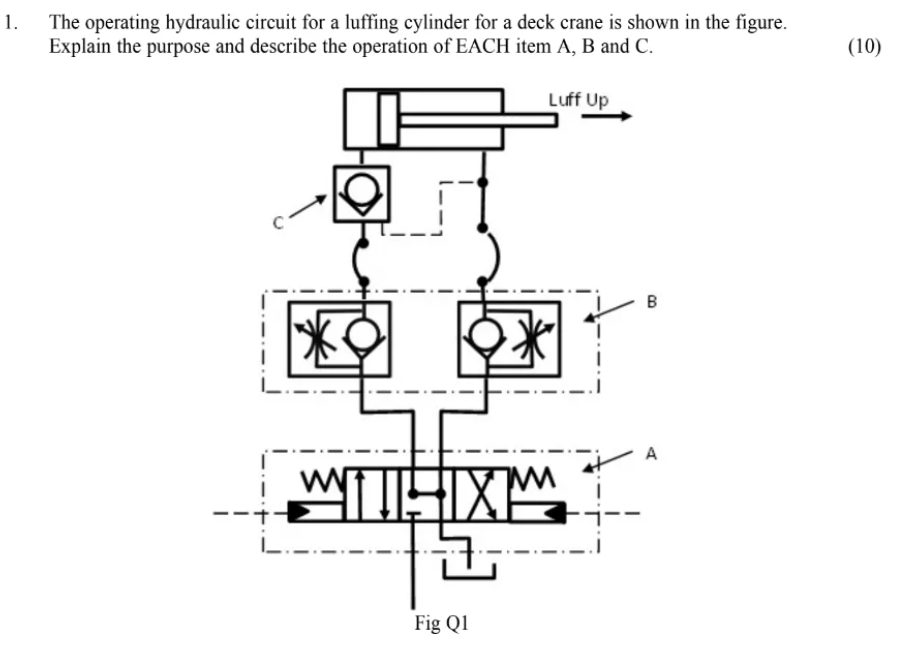
- The operating hydraulic circuit for a luffing cylinder for a deck crane is shown in the figure. Explain the purpose and describe the operation of EACH item A, B and C.
(10) Fig Q1

- With reference to a crane operated by a constant pressure hydraulic system incorporating unidirectional, fixed displacement pumps that run continuously, explain EACH of the following:
(a) the purpose of the accumulator;(2)
(b) how the hydraulic pressure is regulated;(2)
(c) how the speed and direction of the hoist motor is varied;(3)
(d) how the torque available from the hoist motor can be varied.(3)

- Explain the operation of the hydraulic system shown in figure.
Fig Q1

- Describe, with the aid of a sketch, a constant pressure hydraulic power system for a vessel’s Anchor Windlass, showing safety features and labelling ALL components of the system.(10)

- (a) Sketch the hydraulic symbol for a directional control valve.(3)
(b) Describe the operation of EACH of the following hydraulic valves:
(i) directional control valve;(2)
(ii) speed control valve;(2)
(iii) brake valve.(3)

2.(a) Explain why a hydraulic actuator is preferred for a vessel’s stabiliser over an electrical actuator.(5)
(b) Sketch a hydraulic circuit for a single stabiliser, suitable for a constant pressure system.(5)

- Describe, with the aid of a sketch, a hydraulic rack and pinion starting system, labelling the MAIN components.
(10)

Question 2.
Some sketch a standard hydraulic system for e.g. a steering gear. Some give no description. Some show a hydraulic motor.

- Sketch a hydraulic system for adjusting the angle of fin stabilisers, labelling ALL parts.(10)

- With reference to a 440 Volt, 3-phase motor supplied with six terminal connection in the terminal box:
(a) sketch a Delta connection, showing the relationship between phase and line voltages;
(b) sketch a Star connection, showing the relationship between phase and line voltages;(2)
(c) state the relative speed of both connections;(2)
(d) sketch and label the terminal link connections so the motor will run in permanent Delta mode.(4)

- With reference to induction motor starters:
(a) state when a STAR/DELTA starter may be required;
(b) describe the operation of a STAR/DELTA starter;
(c) explain why the motor configuration is changed from STAR to DELTA.

4.(a) Using Worksheet, sketch how an a.c. motor would be connected in EACH of the following:
(i) Star;(3)
(ii) Delta.(3)
(b) State the probable consequences of connecting a motor in star instead of delta.(4)

Question 3.
Although all can show a triangle and star shape many are unable to transfer this to a terminal box layout. Few consider the effect on the distribution system od a large motor starting.

- With reference to variable speed control of a 3 phase ac induction motors:
(a) explain why EACH of the following is not preferred:
(i) variable voltage, constant frequency;(3)
(ii) variable frequency, constant voltage.(3)
(b) explain why voltage and frequency should both be varied. (4)

- With reference to a solid state (inverter) starter for a 3 phase induction motor:
(a) explain the starting characteristics of this system;4)
(b) list the advantages and disadvantages when compared to conventional starting methods.(6)

- Describe, with the aid of a sketch, a variable frequency drive for speed control of a three phase motor.(10)

- With reference to speed control of ac induction motors, explain the function of Pulse Width Modulation (PWM).
(10)

- Explain what happens to the output voltage of an a.c. generator from sudden application of a large load to a steady state condition.(10)
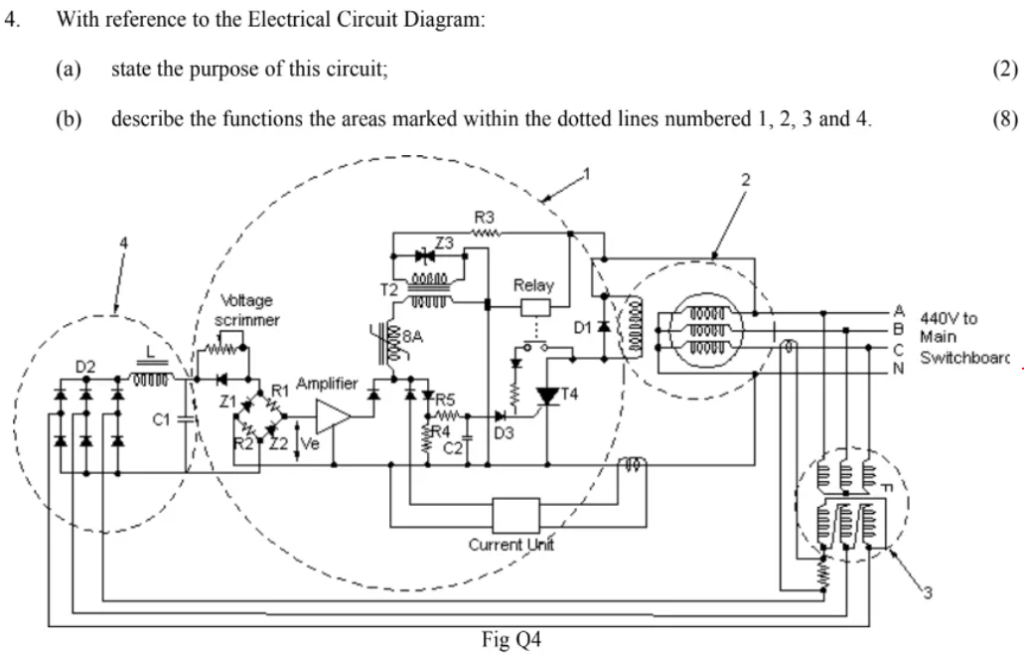
- With reference to the Electrical Circuit Diagram:
(a) state the purpose of this circuit;
(b) describe the functions the areas marked within the dotted lines numbered 1, 2, 3 and 4.

- With reference to storage batteries, explain EACH of the following:
(a) the term UPS;(3)
(b) the operation of an inverter, stating why it may be required;(4)
(c) the term 150 Ah.(3)

3.
(a) Sketch the relationship between true power (kW), apparent power (kVA), reactive power (kVAr) and power factor (coso) in a.c. electrical generation.(4)
(b) Explain how true power (kW) and reactive power (kVAr) is shared between two generators connected in parallel.(4)
(c) State how kW and kVAr load sharing stability is achieved.(2)

- With reference to two identical generators operating in parallel supplying a switchboard that automatically shares load equally, explain EACH of the following:
(a) the effect of the excitation of one generator reducing while the load remains constant;(5)
(b) the possible effects of closing the main circuit breaker when frequency and voltage are equal but phases are out of phase. (5)

- With reference to load sharing of a.c. generators:
(a) state the meaning of the term speed droop;(3)
(b) explain the effect of running generators in parallel with different speed droop settings for EACH of the following:
(i) when the generators are sharing the load equally;(3)
(ii) when the load suddenly increases.(4)

- With reference to AVRS:
(a) explain their purpose;(4)
(b) explain the effects that would be observed should an AVR give a low output when the generator is:
(i) running on its own;(2)
(ii) running in parallel with a second generator whose AVR has no fault.(4)

- Describe, with the aid of a sketch, the operation of a diesel generator speed and load sensing electronic governor, labelling the MAIN components.(10)

- (a) Explain EACH of the following refrigeration terms:
(i) superheated;
(ii) saturation temperature;
(iii) sub-cooled.
(b) Sketch a basic vapour compression refrigeration system, showing the refrigerants condition as explained in part (a).

- With reference to refrigeration systems:
(a) state the THREE basic laws of refrigeration;(6)
(b) state the location and method of re-setting of EACH of the following:
(i) the High Pressure cut out;(2)
(ii) the Low Pressure cut out.(2)
Question 5. Well answered by most.
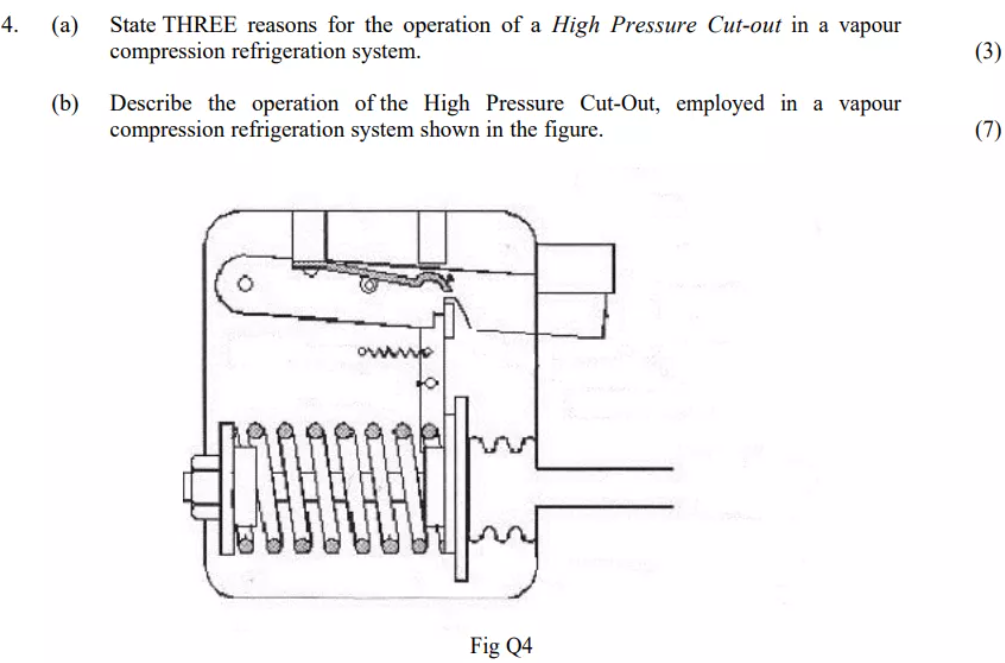
4.(a) State THREE reasons for the operation of a High Pressure Cut-out in a vapour compression refrigeration system.(3)
(b) Describe the operation of the High Pressure Cut-Out, employed in a vapour compression refrigeration system shown in the figure.

- Describe, with the aid of a sketch, the operation of the FOUR main components in a simple vapour compression cycle for a refrigeration system.(10)

- Describe EACH of the following vapour compression refrigeration faults, outlining a possible cause for EACH:
(a) undercharge;(3)
(b) overcharge;(3)
(c) short cycling.(4)

- (a) List FOUR reasons for a refrigeration compressor to stop unexpectedly, after running for a short period.(4)
(b) Describe the faults which lead to TWO of the reasons for the stoppage, listed in part (a).(6)

- Describe the indications of, and the remedies for, an undercharge on a refrigeration system.(10)

- Explain, with the aid of a sketch, the procedure for vapour re-charging of a refrigeration plant.(10)

- State THREE different methods used to detect a refrigerant gas leak, explaining EACH method.(10)

- Describe, with the aid of a sketch, the procedure for Liquid Charging refrigeration plant stating all safety procedures and checks to be carried out. (10)

6.(a) State FOUR properties of refrigeration oil.(4)
(b) Describe the operation of an Oil Separator in a refrigeration system.(4)
(c) State reasons for the employment of an oil separator in refrigeration vapour compression units.(2)

With reference to blended refrigerants, explain EACH of the following terms, stating the refrigerant state required for charging:
(a) azeotrope;
(b) zeotrope;
(c) near-azeotrope.

- With reference to refrigeration systems, explain EACH of the following:
(a) why air is undesirable;(3)
(b) how air may enter;(3)
(c) how air may be removed.(4)

Question 6.
Many fail to understand that a refrigeration system is positively pressurised throughout and give leaks as a cause of ingress of air with no explanation of how a negative pressure can occur. Many state that air can be bled and some mention pumping down but do not explain what this means or the procedure for removing air.
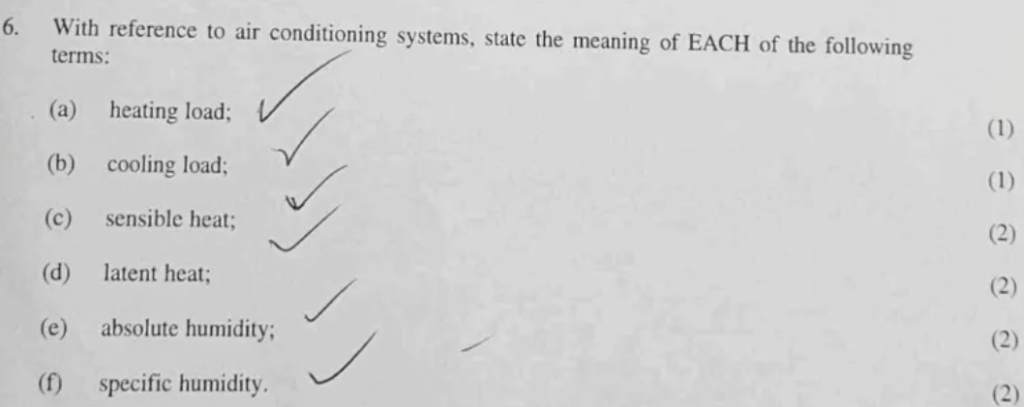
- With reference to air conditioning systems, state the meaning of EACH of the following terms:
(a) heating load;(1)
(b) cooling load;(1)
(c) sensible heat;(2)
(d) latent heat;(2)
(e) absolute humidity;(2)
(f) specific humidity.(2)

5.(a) State THREE types of damper that may be used to control the airflow in an air conditioning system.(3)
(b) Describe, with the aid of a sketch, an automatic fire damper installed in a vertical air duct or in those that pass through bulkheads designated as fire boundaries.(7)

- Describe, with the aid of a sketch, how the relative humidity may be controlled in an Air Conditioning System.(10)

- Describe, with the aid of a sketch, a vapour-compression refrigeration cycle, showing clearly the physical state and condition of the refrigerant in the system.(10)

- Describe, with the aid of a sketch, a Direct Expansion Regrigeration System for an air cooler in an air conditioning installation.(10)

- Sketch an indirect expansion, chilled water air conditioning plant, labelling the MAIN components.(10)

- Describe the effects of EACH of the following contaminants when found in air required for breathing and diving use:
(a) oil vapour;(4)
(b) water vapour;(4)
(c) overheated oil.(2)

7.(a) Describe TWO possible sources of contamination of compressed air used for breathing.(4)
(b) State THREE contaminants that may be found in compressed air, outlining the effect of the contaminant on the user when the compressed air is used for diving (SCUBA) purposes.(6)

7.(a) Sketch a Chemical Filter tower supplying air suitable for breathing and diving, labelling ALL elements.(4)
(b) Explain the purpose of TWO of the filter elements sketched in part(a).

Explain the maintenance and inspection that should be carried out on SCUBA cylinders.(10)

- Describe, with the aid of a sketch, a three-stage air compressor system, suitable for compressed air diving equipment. (SCUBA).
(10)

- With reference to the Code of Safe Working Practices for Merchant Seamen and maintenance of lifting equipment:
(a) state the interval between testing and who should carry out the testing;(2)
(b) state the name of the document where details of the vessel’s lifting gear is kept;(1)
(c) state the meaning of SWL;(1)
(d) state the possible reasons for needing to take a piece of lifting equipment out of service, explaining the measures to be taken before it can be returned to service.(6)

- With reference to the Code of Safe Working Practices for Merchant Seamen and maintenance of lifting equipment:
(a) outline FIVE maintenance procedures to be carried out on lifting equipment;(5)
(b) state who should carry out the examination of the lifting equipment, the interval between examinations and the defects that may be found.(5)

(a) State the maximum time periods between EACH of the following lifting equipment requirements:
(i) inspection;
(ii) testing.
(b) Describe the inspection routine for lifting gear.(6)
(c) State the procedure for recording the results of the inspection and tests.(2)

7.(a) A crane is being fitted to deploy and recover a load from a vessel. With reference to the present regulations, state the standards that the crane must comply with before being used on board.
(b) State the information entered on a Proof Load Test certificate.(3)
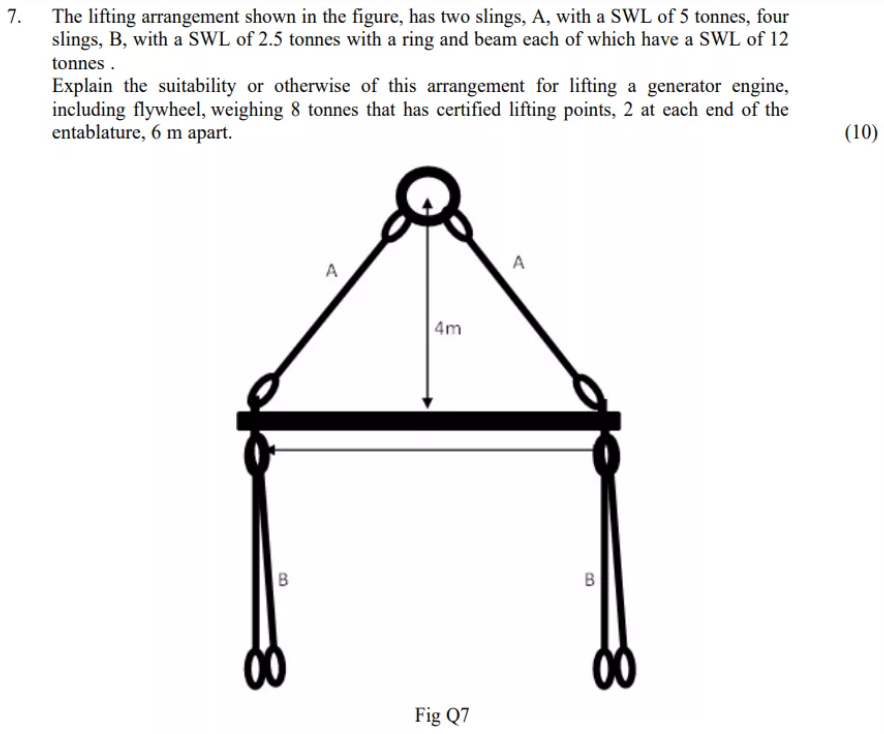
- The lifting arrangement shown in the figure, has two slings, A, with a SWL of 5 tonnes, four slings, B, with a SWL of 2.5 tonnes with a ring and beam each of which have a SWL of 12 tonnes.
Explain the suitability or otherwise of this arrangement for lifting a generator engine, including flywheel, weighing 8 tonnes that has certified lifting points, 2 at each end of the entablature, 6 m apart.
(10)

- With reference to Open Flame Gas Installation, describe the safety requirements for the installation of EACH of the following:
(a) cylinders and attachments;(5)
(b) fittings and pipework.(5)

8. (a) State THREE dangers arising from the use of LPG open flame appliances.(3)
(b) Describe the requirements for a Gas Detector suitable for a LPG installation.(7)

- State the requirements for the stowage of hand portable petrol containers, in small lockers on open deck.(10)

9.State the safety requirements for small lockers on open deck storing petrol and other highly inflammable liquids in hand portable containers.
(10)

- With reference to the storage of volatile fuels, describe the construction and placement requirements of the storage tanks for aviation fuel, including tank ventilation.(10)

8. Describe the safety requirements for the electrical installation in a large locker on deck, designated for the carriage of petrol, or vehicles with fuel in their tanks.(10)

- (a) Describe, with the aid of a sketch, the securing arrangement for a pipe passing through a watertight bulkhead.(5)
(b) Sketch an arrangement for a watertight electric cable gland labelling ALL components.(5)

9.(a) State the purpose of the collision bulkhead and the regulations appertaining to its dimensions and position.(4)
(b) Explain the difference between A, B and C class bulkheads.(6)

9.Sketch the device which allows a cable to pass through a watertight bulkhead, labelling the MAIN components.(10)

9 Describe, with reasons, the features of watertight doors fitted to the weather deck.(10)

Question 9. Mainly well answered
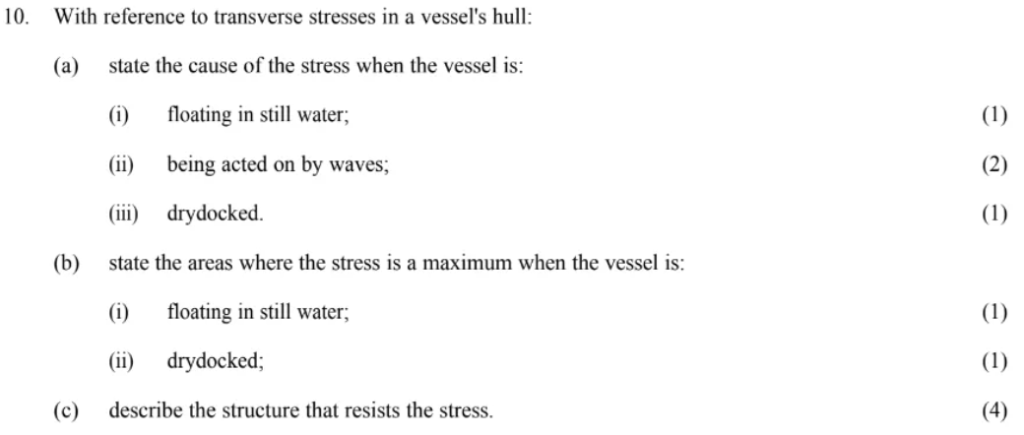
- With reference to transverse stresses in a vessel’s hull:
(a) state the cause of the stress when the vessel is:
(i) floating in still water;(1)
(ii) being acted on by waves;(2)
(iii) drydocked.(1)
(b) state the areas where the stress is a maximum when the vessel is:
(i) floating in still water;(1)
(ii) drydocked;(1)
(c) describe the structure that resists the stress.(4)

- (a) Define the term sheer stress.(3)
(b) Explain how the hull of a vessel may be subject to sheer stress in EACH of the following:
(i) while in a seaway;(4)
(ii) while in still water.(3)

- (a) Explain what is meant by the term pounding as applied to a vessel being driven hard in a seaway.(3)
(b) Explain how panting may often occur at the same time as pounding in heavy seas.(3)
(c) Describe how the hull is strengthened to resist panting and pounding.(4)

- With reference to a vessel’s hull:
(a) explain the meaning of EACH of the following:
(i) dynamic stress;(3)
(ii) static stress;(3)
(b) state TWO examples of EACH type of stress explained in part (a).(4)

- With reference to longitudinal stresses in a vessel’s hull:
(a) state the cause of the stress;
(b) state the areas where the stress is a maximum;
(c) describe the structure that resists the stress.

- With reference to the application of protective coatings to a vessel’s hull:
(a) state the functions that the coating should perform;(3)
(b) state the legislation that applies to certain coatings and what certification is required to comply with it;(2)
(c) outline the process for re-coating the hull of a vessel in drydock.(5)

- With reference to a vessel’s hull:
(a) state the meaning of the term racking;(2)
(b) explain how racking occurs;(4)
(c) state the structures that resist racking.(4)

- With reference to stresses and strain in vessels, describe, with the aid of a sketch, EACH of the following:
(a) panting;(2)
(b) pounding;(2)
(c) racking;(2)
(d) hogging;(2)
(e) sagging;(2)

- Explain the cause and effect of vibration on a vessel.(10)

8.Describe the annual airtight integrity test and examination that is required to be carried out on an inflatable or rigid inflatable craft.
(10)

- (a) List THREE defects that may be found during an inspection of a fixed bladed propeller, stating the possible cause of EACH.(6)
(b) State the likely consequences if the defects stated in part (a) are not rectified.(4)

- With reference to surface preparation for the painting of a vessels hull in dry-dock, list the advantages and disadvantages of EACH of the following methods:
(a) abrasive blasting;(5)
(b) hydroblasting.(5)

With reference to the visual inspection of lifting gear before use, state the removal from service criteria for EACH of the following slings when visually inspecting before use:
(a) wire rope;
(b) synthetic fibre.
Note: The slings are within inspection dates, are of the correct SWL and clearly labelled.

- With reference to a reciprocating air compression:
(a) define the term Volumetric Efficiency;(4)
(b) explain how the operation of the suction and delivery valves affect the volumetric efficiency of the compressor.(6)

- With reference to a vessel’s motion control:
(a) outline the SIX degrees of freedom;
(b) explain the term damping;(4)
(c) state THREE considerations to be made, before the installation of a motion reduction system.(3)

- Describe the procedure that should be followed if an outboard motor has been submerged in sea water.(10)

- With reference to the International Convention for the Safe and Environmentally Sound Recycling of Ships:
(a) state the operational requirements for compliance;(4)
(b) list FOUR prohibited hazardous materials;(4)
(c) list TWO hazardous materials whose use should be restricted.(2)